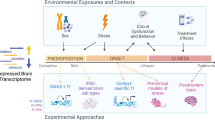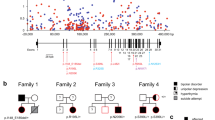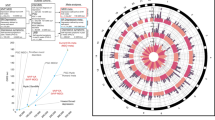Abstract
APAF1, encoding the protein apoptosis protease activating factor 1 (Apaf-1), has recently been established as a chromosome 12 gene conferring predisposition to major depression in humans. The molecular phenotypes of Apaf-1 variants were determined by in vitro reconstruction of the apoptosome complex in which Apaf-1 activates caspase 9 and thus initiates a cascade of proteolytic events leading to apoptotic destruction of the cell. Cellular phenotypes were measured using a yeast heterologous expression assay in which human Apaf-1 and other proteins necessary to constitute a functional apoptotic pathway were overexpressed. Apaf-1 variants encoded by APAF1 alleles that segregate with major depression in families linked to chromosome 12 shared a common gain-of-function phenotype in both assay systems. In contrast, other Apaf-1 variants showed neutral or loss-of-function phenotypes. The depression-associated alleles thus have a common phenotype that is distinct from that of non-associated variants. This result suggests an etiologic role for enhanced apoptosis in major depression.
This is a preview of subscription content, access via your institution
Access options
Subscribe to this journal
Receive 12 print issues and online access
$259.00 per year
only $21.58 per issue
Buy this article
- Purchase on Springer Link
- Instant access to full article PDF
Prices may be subject to local taxes which are calculated during checkout



Similar content being viewed by others
References
Abkevich V, Camp N, Hensel C, Neff C, Russell D, Hughes D et al. Predisposition locus for major depression at chromosome 12q22–12q23.2. Am J Hum Genet 2003; 73: 1271–1281.
Zou H, Henzel W, Liu X, Lutschg A, Wang X . Apaf-1, a human protein homologous to C. elegans CED4, participates in cytochrome c dependent activation of caspase 3. Cell 1997; 90: 405–413.
Acehan D, Jiang X, Morgan D, Heuser J, Wang X, Akey C . Three-dimensional structure of the apoptosome: implications for assembly, procaspase-9 binding, and activation. Mol Cell 2002; 9: 423–432.
Rodriguez J, Lazebnik Y . Caspase-9 and Apaf-1 form an active holoenzyme. Genes Dev 1999; 13: 3179–3184.
Zou H, Li Y, Liu X, Wang X . An APAF-1-cytochrome c multimeric complex is a functional apoptosome that activates procaspase-9. J Biol Chem 1999; 274: 11549–11556.
Hawkins C, Silke J, Verhagen A, Foster R, Ekert P, Ashley D . Analysis of candidate antagonists of IAP-mediated caspase inhibition using yeast reconstituted with the mammalaian Apaf-1-activated apoptosis mechanism. Apoptosis 2001; 6: 331–338.
Duman R, Heninger G, Nestler E . A molecular and cellular theory of depression. Arch Gen Psychiatry 1997; 54: 597–606.
Duman R, Malberg J, Thome J . Neural plasticity to stress and antidepressant treatment. Biol Psychiatry 1999; 46 (1181–1191).
Altar A . Neurotrophins and depression. Trends Pharmacol Sci 1999; 20: 59–61.
Santarelli L, Saxe M, Gross C, Surget A, Battaglia F, Dulawa S et al. Requirement of hippocampal neurogenesis for the behavioral effects of antidepressants. Science 2003; 301: 805–809.
Lucassen P, Fuchs E, Czéh B . Antidepressant treatment with tianeptine reduces apoptosis in the hippocampal dentate gyrus and temporal cortex. Biol Psychiatry 2004; 55: 789–796.
Mumberg D, Muller R, Funk M . Regulatable promoters of Saccharomyces cerevisiae: comparison of transcriptional activity and their use for heterologous expression. Nucleic Acids Res 1994; 22: 5767–5768.
Guthrie C, Fink G . Guide to Yeast Genetics and Molecular Biology. Academic Press, Inc.: San Diego CA, 1991.
Hu Y, Benedict M, Ding L, Nunez G . Role of cytochrome c and dATP/ATP cytolysis in Apaf-1-mediated caspase-9 activation and apoptosis. EMBO J 1999; 18: 3586–3595.
Jiang X, Wang X . Cytochrome c promotes caspase-9 activation by inducing nucleotide binding to Apaf-1. J Biol Chem 2000; 275: 31199–31203.
Hu Y, Ding L, Spencer D, Nuñez G . WD-40 repeat region regulates Apaf-1 self-association and procaspase-9 activation. J Biol Chem 1998; 273: 33489–33494.
Srinivasula S, Ahmad M, Fernandes-Alnemri T, Alnemri E . Autoactivation of procaspase-9 by Apaf-1-mediated oligomerization. Mol Cell 1998; 1: 949–957.
Inohara N, Nuñez G . The NOD: a signaling module that regulates apoptosis and host defense against pathogens. Oncogene 2001; 20: 6473–6481.
Li P, Nijhawan D, Budihardjo I, Srinivasula S, Ahmad M, Alnemri E et al. Cytochrome c and dATP-dependent formation of Apaf-1/caspase-9 complex initiates an apoptotic protease cascade. Cell 1997; 91: 479–489.
Riedl SJ, Li W, Chao Y, Schwarzenbacher R, Shi Y . Structure of the apoptotic protease-activating factor 1 bound to ADP. Nature 2005; 434: 926–933.
McEwen B . Stress and hippocampal plasticity. Annu Rev Neurosci 1999; 22: 105–122.
Gould E, Tanapat P, McEwen B, Flugge G, Fuchs E . Proliferation of gramule cells precursors in the dentate gyrus of adult monkeys is diminished by stress. Proc Natl Acad Sci USA 1998; 95: 3168–3171.
Smith M, Makino S, Kvetnansky R, Post R . Stress and glucocoticoids affect the expression of brain-derived neurotrophic factor and neurotrophin-3 mRNAs in the hippocampus. J Neurosci 1995; 15: 1768–1777.
Sheline Y, Mintun M . Structural and functional imaging of affective disorders. In: Nemeroff C (ed). Neuropsychopharmacology: The Fifth Generation of Progress. Lippincott Williams & Wilkins: Philadelphia PA, 2002, pp 1065–1080.
Drevets W . Neuroimaging and neuropathological studies of depression: implications for the cognitive-emotional features of mood disorders. Curr Opin Neurobiol 2001; 11: 240–249.
Shirayama Y, Chen A, Nakagawa S, Russell D, Duman R . Brain-derived neurotrophic factor produces antidepressant effects in behavioral models of depression. J Neurosci 2002; 22: 3251–3261.
Siuciak J, Lewis D, Wiegand S, Lindsay R . Antidepressant-like effect of brain-derived neurotrophic factor (BDNF). Pharmacol Biochem Behav 1997; 56: 131–137.
Nibuya M, Nestler E, Duman R . Chronic antidepressant administration increases the expression of cAMP response element binding protein (CREB) in rat hippocampus. J Neurosci 1996; 16: 2365–2372.
Malberg J, Eisch A, Nestler E, Duman R . Chronic antidepressant treatment increases neurogenesis in adult rat hippocampus. J Neurosci 2000; 20: 9104–9110.
Botteron K, Raichle M, Heath A, Price A, Sternhell K, Singer T et al. An epidemiological twin study of prefrontal neuromorphometry in early onset depression. Biol Psychiatry 1999; 45: 59S.
Author information
Authors and Affiliations
Corresponding author
Rights and permissions
About this article
Cite this article
Harlan, J., Chen, Y., Gubbins, E. et al. Variants in Apaf-1 segregating with major depression promote apoptosome function. Mol Psychiatry 11, 76–85 (2006). https://doi.org/10.1038/sj.mp.4001755
Received:
Revised:
Accepted:
Published:
Issue Date:
DOI: https://doi.org/10.1038/sj.mp.4001755
Keywords
This article is cited by
-
Hippocampus-specific regulation of long non-coding RNA and mRNA expression in germ-free mice
Functional & Integrative Genomics (2020)
-
Effects of anti-depressant treatments on FADD and p-FADD protein in rat brain cortex: enhanced anti-apoptotic p-FADD/FADD ratio after chronic desipramine and fluoxetine administration
Psychopharmacology (2016)
-
Elevated Monoamine Oxidase A Binding During Major Depressive Episodes Is Associated with Greater Severity and Reversed Neurovegetative Symptoms
Neuropsychopharmacology (2014)
-
Evidence for HTR1A and LHPP as interacting genetic risk factors in major depression
Molecular Psychiatry (2009)
-
Repeated Unpredictable Stress and Antidepressants Differentially Regulate Expression of the Bcl-2 Family of Apoptotic Genes in Rat Cortical, Hippocampal, and Limbic Brain Structures
Neuropsychopharmacology (2008)



